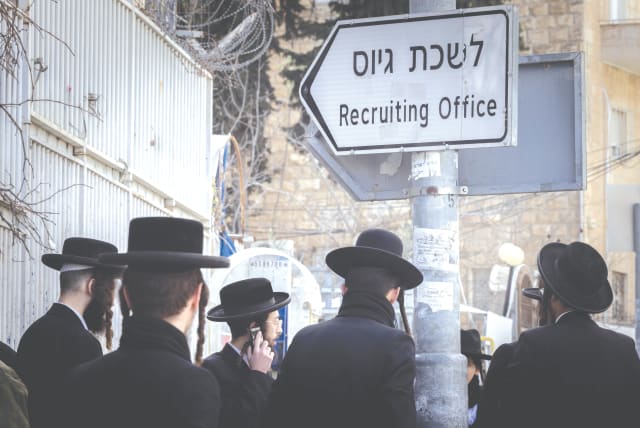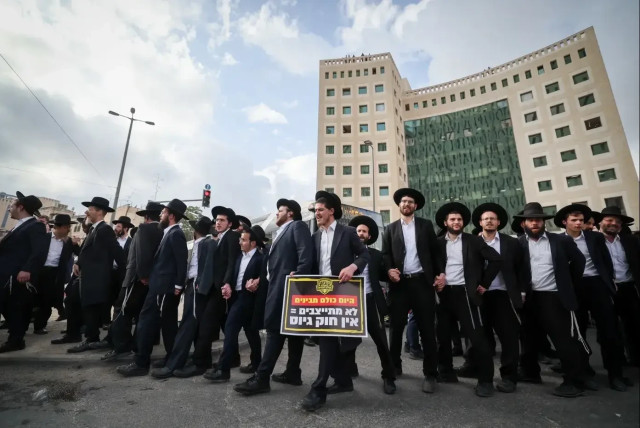How many Haredim can the IDF really absorb in near future? - Explainer

This week, the IDF also leaked a potential plan for having Haredim serve as border security in the West Bank without having to formally join the IDF.
There are many “elephants in the room” surrounding the issue of haredim serving in the IDF, one of them being that it is not at all clear that the military at this time – or in the next year – would have the capacity to absorb a large influx of ultra-Orthodox recruits.
General statistics from prior years – the IDF has not shared any recently – show that through 2021, around 10% of 12,000 eligible haredim were drafting per year.
Even though at the start of the war, the IDF made vague claims about a sudden influx of 2,000 haredim, anecdotal evidence suggests that the final number of draftees did not change the picture at all.
What the IDF is desperate for post-October 7 is combat fighters; the number of haredi combat fighters is even smaller, in the low hundreds.
Even the term, as it applies in the military, is murky. Many of those labeled “haredi” are, in fact, better described as right-wing religious Zionists, or ex-haredim. Both categories have some commonalities with the generic haredi young adult but are different enough in critical ways that they are written off by the majority of haredim as not representing the community.
Of course, the lion’s share of changing the situation will be convincing the haredi community, both from the top-down and bottom-up, to allow more to draft.
But even if they do that, could the IDF absorb them?
The Jerusalem Post queried the military on these issues and did not receive a response by press time. This, combined with the fact that the military failed to properly address the issue for the past few years, could suggest that its capacity to take in new large volumes of haredi conscripts may be much lower than what it tries to portray.
When it does give answers, they jump quickly to examples of where drafting and integration work, like the Netzah Yehuda battalion, the Tomer Givati Company, the Hetz Company in the Paratroopers Brigade, and the Magen Negev Company. But these are exceptions.
In December, Planning and Personnel Administration Brigade Commander Brig.-Gen. Shay Taib told a Knesset committee about a new program that drafts haredim over the age of 26 – when their exemption becomes permanent, and rabbis are less worried about the religious and social consequences of their drafting.
However, this entire program includes about 450 haredim, none of whom serves for very long or are in combat.
There is an elite program employing around 150 haredi women in technological capacities, but again, the numbers are relatively insignificant; they are technically civilians employed by the IDF.
The military recently leaked stories about establishing new yeshivot on the borders and establishing new haredi border security units connected to those yeshivot.
This week, the IDF also leaked to Yediot Aharonot – and confirmed by the Post – a potential plan for having haredim serve in border security in the West Bank without having to formally join the military and deal with the bureaucracy.These ideas, at the moment, are merely on paper, with no real detailed plans or movement to start setting up infrastructure.
Some commentators have said the IDF should first fill up all of the slots it has in existing programs before it invests huge amounts of money and high command planning work to develop new out-of-the-box ones.
But the fact is that if haredim might serve in the IDF in numbers anywhere close to even the modest goal of a few thousand, according to the law passed (and repealed by the haredi parties a year later) by Yesh Atid chairman MK Yair Lapid in 2014, all of the existing programs and all of the new ones would likely be insufficient.
To take in thousands more, there would still likely need to be many more roles and programs, and that’s without getting anywhere near the approximate two-thirds average draft numbers among other sectors.
Following a Defense Ministry report in 2018, a report came out from former major-general Roni Numa accusing it of retaining wishy-washy definitions of “haredi.” Numa’s report found that the IDF was not prepared to absorb new haredi recruits in any significant numbers.
The question is, why not?
This in itself has produced some serious debate, but the answer is probably a combination of reasons.First, the IDF is exhausted by failed attempts to recruit haredim, along with large amounts of time and money wasted on the issue – when the political establishment makes promises but does not follow through.
Second, there are multiple objective reasons for the IDF to not want people from the sector, even though it believes in the principle of equal service. When they do draft, haredim tend to cost the army more of its budget because they get married earlier and have kids earlier, incurring significant additional jumps in salary even before they are officers.Additionally, male haredim demand separation from women in a much more complete way than some religious-Zionist men, who may want to serve in all-male units on a day-to-day basis but have no problem interacting with women as part of the IDF’s female bureaucracy.
Taking in a huge influx of haredim would mean building almost a separate parallel army, including separate intake centers, training camps, and post-training bases. It would also mean training a larger number of men to carry out recruiting, vetting, and financial assistance roles most frequently filled by women.
This will require checks and balances to make sure it does not lead to a new wave of discrimination against women in the military, especially at a time when it likely needs more women in combat units as well.
Not that any of these obstacles prevent the project from advancing.
On October 7, reservist responses to the war were estimated at surprising numbers – 150% – including officers who had been off reserve roles for over a decade.
The army and the country can move mountains when there is a decision that a crisis must be overcome. This means the country and the IDF will confront the crisis much better if they recognize the fact that “success” will truly require moving mountains.
Jerusalem Post Store
`; document.getElementById("linkPremium").innerHTML = cont; var divWithLink = document.getElementById("premium-link"); if (divWithLink !== null && divWithLink !== 'undefined') { divWithLink.style.border = "solid 1px #cb0f3e"; divWithLink.style.textAlign = "center"; divWithLink.style.marginBottom = "15px"; divWithLink.style.marginTop = "15px"; divWithLink.style.width = "100%"; divWithLink.style.backgroundColor = "#122952"; divWithLink.style.color = "#ffffff"; divWithLink.style.lineHeight = "1.5"; } } (function (v, i) { });

